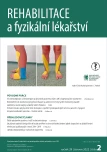The effect of kinesio taping and kinesio therapy on dynamic gait parameters in children with hyperpronation syndrome
Authors:
Honzíková L. 1; Dlugošová D. 1; Kočišová B. 1; Janura M. 1,2; Zahutová E. 1; Barot T. 3
Authors‘ workplace:
Ústav rehabilitace, Lékařská fakulta, Ostravská univerzita
1; Katedra přírodních věd v kinantropologii, Fakulta tělesné kultury, Univerzita Palackého v Olomouci
2; Katedra matematiky s didaktikou, Pedagogická fakulta, Ostravská univerzita
3
Published in:
Rehabil. fyz. Lék., 29, 2022, No. 2, pp. 56-62.
Category:
Original Papers
doi:
https://doi.org/10.48095/ccrhfl202256
Overview
The aim of the study was to assess the effect of kinesio taping and kinesiotherapy on the dynamic gait parameters of preschool children with hyperpronation syndrome. A total of 30 children (age 5.4 ± 0.4 years) with bilateral valgus heel (9.5° ± 2.4°) participated in the study. The children were randomly assigned to one of three groups: experimental group with kinesio taping, experimental group with kinesiotherapy, and control group without therapy. Dynamic gait parameters were evaluated using a dynamic treadmill Rehawalk® (h/p/cosmos®, Germany) before therapy and after three months of therapy. Due to the significant reduction in pronation in the subtalar joint in both experimental groups following therapy, the hindfoot became more stable at the expense of a reduced shock absorption ability, but with better conditions for transfer of load and push-off. In the kinesio taping group the push-off after therapy was more dynamic thanks to the firmer stabilisation of the hindfoot. In the kinesiotherapy group there was a reduction in the force loading of the midfoot as well as in the overall time of loading of this area and the forefoot area. Kinesio taping and kinesiotherapy could become effective methods in the treatment of hyperpronation syndrome in preschool children.
Keywords:
foot – force loading – heel valgus – zebris
Sources
1. Vařeka I, Vařeková R. Kineziologie nohy. Olomouc: Univerzita Palackého v Olomouci 2009.
2. Wernick J, Volpe RG. Lower extremity function and normal mechanics. In: Valmassy (Ed.). Clinical biomechanics of the lower extremities. St. Louis, Mosby 1996 : 1–58.
3. Gould N, Moreland M, Alvarez R et al. Development of the child’s arch. Foot Ankle 1989; 9(5): 241–245. doi: 10.1177/107110078900900506.
4. Rao UB, Joseph B. The influence of footwear on the prevalence of flat foot. A survey of 2300 children. J Bone Joint Surg Br 1992; 74(4): 525 – 527. doi: 10.1302/0301-620X.74B4.1624509.
5. Vondrašová P. Kinezioterapie versus podologie dětské nohy. Umění fyzioterapie: Dětská noha 2016; 1(1): 37–40.
6. Lewit K, Lepšíková M. The role of the feet as an important part of the stabilization system. Int Musculoskelet Med 2012; 34(2): 55–61. doi: 10.1 179/175361512X13197102543030.
7. Maršáková K, Pavlů D. Diagnostika funkce nohy v denní praxi. Rehabil Fyz Lék 2012; 19(4): 177–180.
8. Resende RA, Pinheiro LSP, Ocarino JM. Effects of foot pronation on the lower limb sagittal plane biomechanics during gait. Gait Posture 2019; 68 : 130–135. doi: 10.1016/j.gaitpost.2018.10. 025.
9. Ranker A, Lemhöfer C. Sensomotorisch wirkende Fußorthesen (SMFO) – Ein Überblick. Physikalische Medizin, Rehabilitationsmedizin, Kurortmedizin 2019; 29(2): 74–77. doi: 10.1055/a-0577-0491.
10. Siu WS, Shih Y-F, Lin H-C. Effects of Kinesio tape on supporting medial foot arch in runners with functional flatfoot: a preliminary study. Res Sports Med 2020; 28(2): 168–180. doi: 10.1080/15438627.2019.1638258.
11. Dobeš M, Kolář P, Dyrhonová O. Hlezno a noha. In: Kolář et al. Rehabilitace v klinické praxi. Praha: Galén 2009 : 510–516.
12. Riccio I, Gimigliano F, Gimigliano R et al. Rehabilitative treatment in flexible flatfoot: a perspective cohort study. Chir Organi Mov 2009; 93(3): 101–107. doi: 10.1007/s12306-009-0037-z.
13. Kenzo M, Yasukawa P, Kase A et al. Kinesio taping in pediatrics: fundamentals and whole body taping. 2nd ed. USA: Orthopedic Physical Therapy and Rehabilitation Produ 2006.
14. Kobrová J, Válka R. Terapeutické využití tejpování. Praha: Grada Publishing 2017.
15. Hammer Ø, Harper DAT, Ryan PD. PAST: Paleontological statistics software package for education and data analysis. Palaeontologia Electronica 2001; 4(1).
16. Cohen J. A power primer. Psychol Bull 1992; 112(1): 155–159. doi: 10.1037//0033-2909.112.1. 155.
17. Michaud TC. Foot orthoses and other forms of conservative foot care. Newton Massachusetts: Thomas C. Michaud 1997.
18. Maetzler M, Bochdansky T, Abboud RJ. Normal pressure values and repeatability of the Emed® ST2 system. Gait Posture 2010; 32(3): 391–394. doi: 10.1016/j.gaitpost.2010.06.023.
19. Straczynska A, Kruczynski J, Radziminska A et al. The positive role of kinesio taping in adjunctive therapy of static plano-valgus feet in children between the ages of 5 and 7. Balt J Health Phys Act 2017; 9(2): 89–97. doi: 10.29359/ BJHPA.09.2.09.
20. Yaguramaki N, Nishizawa S, Adachi K et al. The relationship between posture and external force in walking. Anthropol Sci 1995; 103(2): 117–139.
Labels
Physiotherapist, university degree Rehabilitation Sports medicineArticle was published in
Rehabilitation & Physical Medicine

2022 Issue 2
Most read in this issue
- Rehabilitation treatment of lateral epicondylitis
- The effect of kinesio taping and kinesio therapy on dynamic gait parameters in children with hyperpronation syndrome
- Musculoskeletal disorders in wind instruments players
- Effectiveness of physiotherapeutic interventions in the treatment of patients with myogenic temporomandibular disorder with reduced jaw opening – a literature review
